

Horses' hooves thundered down the coast to the interior of the province of Sicilia. The senator's son and his two companions stopped by a stream to give their horses a rest and a chance to drink some water. The three young men warily watched the road behind them and listened intently for sounds of pursuers. Confident that they weren't being followed, they too helped themselves to the cool water.
Dawn had broken an hour before and a thin mist rose from the ground. The crisp fall air carried the heady aroma of burning vines as farmers cleared their fields following the grape and olive harvests. Make no mistake though, this was a wild and dangerous country, dangers far different from those in Rome. The young men were somewhat accustomed to intrigue and deceit but were not accustomed to an attack by a savage wild boar or from a suspicious military veteran turned farmer. They quickly re-mounted their horses and resumed their ride.
Their destination was a villa whose owner would welcome the senator's son and give refuge to the three young men. As the sun rose in the sky, they finally saw multiple plumes of smoke signaling their destination. When they arrived at the villa, slaves took their horses to the stables.
The dominus had been alerted to the approach of the three young men. While their identities were not given, he was quite certain that he knew them and was not surprised by their visit. He ordered his slaves to afford them every courtesy appropriate to people of senatorial rank.
The young men knew of the villa. Even by Imperial standards it was legendary. The mosaics were said to be the most beautiful in the civilized world. After taking their horses, the household slaves led the men to the baths.
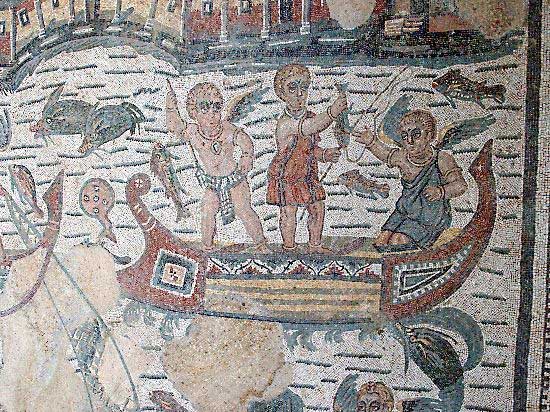
The mosaics depicting fishing scenes made the young men hungry. Like all Romans, they loved fish. Slaves brought in watered wine and small snacks of salted olives and smelts. Following the long ride, baths and wine the young men almost fell asleep.
The slaves then led the senator's son and his companions into another room to rest. This was the Room of the Small Hunt, a living room for guests. The floor mosaics depicting a hunt initially woke them up because they were so vivid.
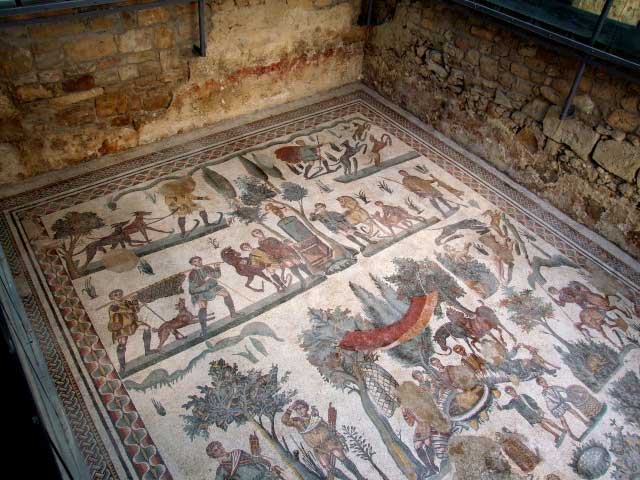
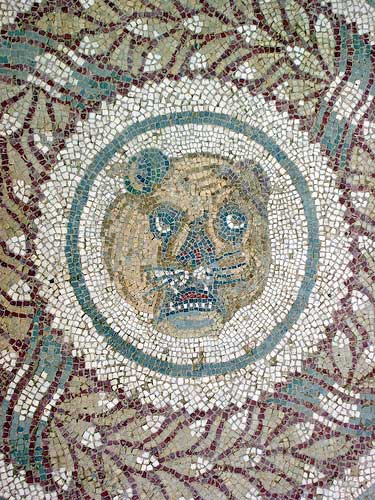 But soon, the senator's son and one companion fell into a deep sleep. The second companion, however, was intrigued by the mosaics as his father was a very wealthy collector of art. The young man knew these exquisite mosaics were likely to be the work of masters from North Africa. He quietly left the room of the Small Hunt and entered the peristyle which was a rectangular court around a central garden and fountain. His eyes however were on the floor of the peristyle that was covered in mosaic medallions.
But soon, the senator's son and one companion fell into a deep sleep. The second companion, however, was intrigued by the mosaics as his father was a very wealthy collector of art. The young man knew these exquisite mosaics were likely to be the work of masters from North Africa. He quietly left the room of the Small Hunt and entered the peristyle which was a rectangular court around a central garden and fountain. His eyes however were on the floor of the peristyle that was covered in mosaic medallions.
He walked quietly and was careful to attract no attention to himself. As he turned a corner, he heard laughing voices and sounds of sports. The noises sounded like those of young children, possibly children of the dominus and domina. The young man looked into an exercise room where children were playing a game with a ball. The floor was covered with mosaics of young women exercising.
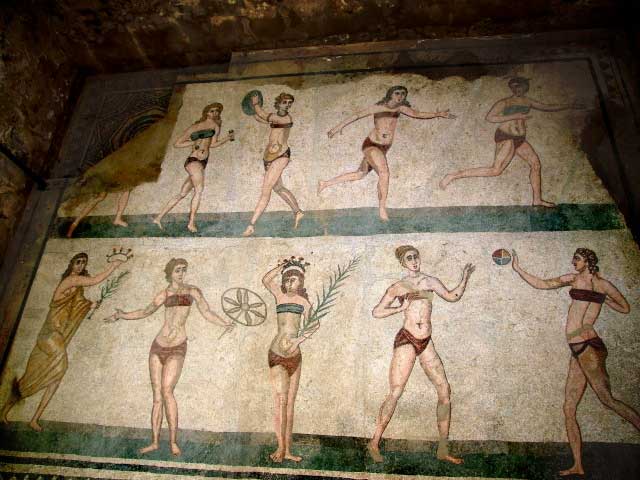
The young man quietly left the room and returned to the Room of the Small Hunt for a deep sleep. Before he arrived there however, he had a chance to look quickly into the bedroom of the dominus and domina and then very quickly left.
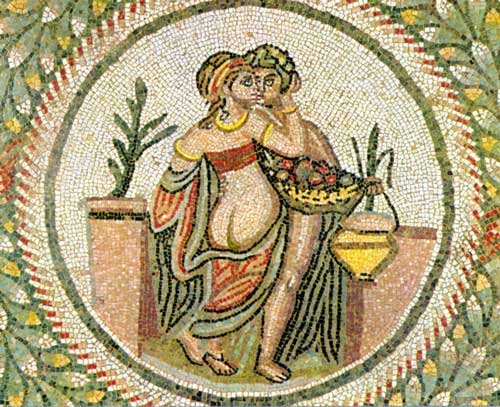
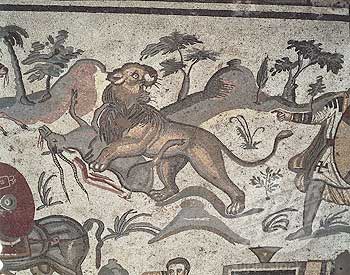
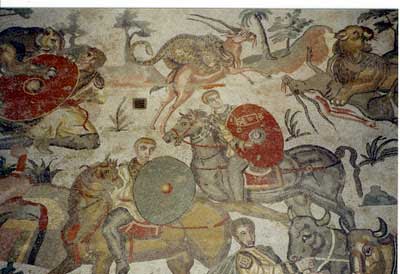 The senator's son and his companions slept uninterrupted until slaves awoke them with fresh togas for dinner. They followed a slave to the triclinium by way of the Hall of the Big Hunt. The dominus had estates in Africa and the mosaics depicted scenes of hunting all varities of exotic animals. The senator's son had seen many of these animals in the Colliseum, but never as they looked in the wild. Understandably, the young men tarried.
The senator's son and his companions slept uninterrupted until slaves awoke them with fresh togas for dinner. They followed a slave to the triclinium by way of the Hall of the Big Hunt. The dominus had estates in Africa and the mosaics depicted scenes of hunting all varities of exotic animals. The senator's son had seen many of these animals in the Colliseum, but never as they looked in the wild. Understandably, the young men tarried.
Several slaves hurriedly rushed from the triclinium to escort the young men to dinner. As they approached the triclinium , the young men smelled the wild boar before seeing it. It was stuffed with figs and chestnuts. The young men stood nervously in the doorway, not quite knowing what to expect since their departure from Rome was so sudden and under questionable circumstances.
The dominus then came to them and asked, "So, what is the news from Rome?"
Villa Romana del Casale is located in central Sicily, 3.5 miles from Piazza Armerina. The villa was built between 310 - 340 AD as either a hunting lodge or a latifundiam, a large agricultural estate. The sheer size and beauty of the villa indicates that it was built by a wealthy patrician or possibly even Maximanus, co-emperor of Diocletian.
The unique features of the villa are its floors which are covered entirely by excellently preserved mosaics. The mosaics cover approximately 3500 square meters in over 40 rooms. Not only are the mosaics beautifully crafted, but they depict an extraordinary number of scenes from Roman life and culture - everyday life, Gods and myths, circus games, harvests, hunting, fishing, wild animals and the famous bikini girls. It is believed that the work is that of craftsmen from North Africa. While all of the mosaics are stunning, the most dramatic are those in The Corridor of the Great Hunt which shows scenes of wild animals being captured and loaded onto ships to be sent to the games in Italy.
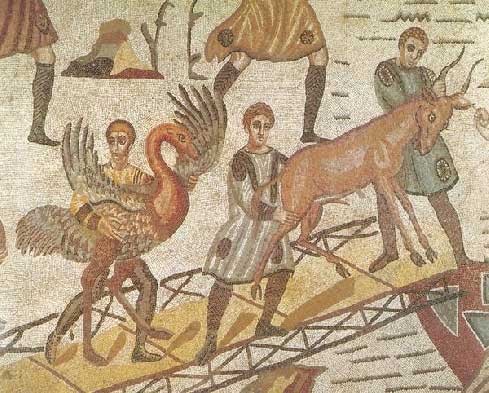
An excellent website for viewing pictures of the mosaics is:
http://www.thejoyofshards.co.uk/visits/sicily/romana
Cielolama